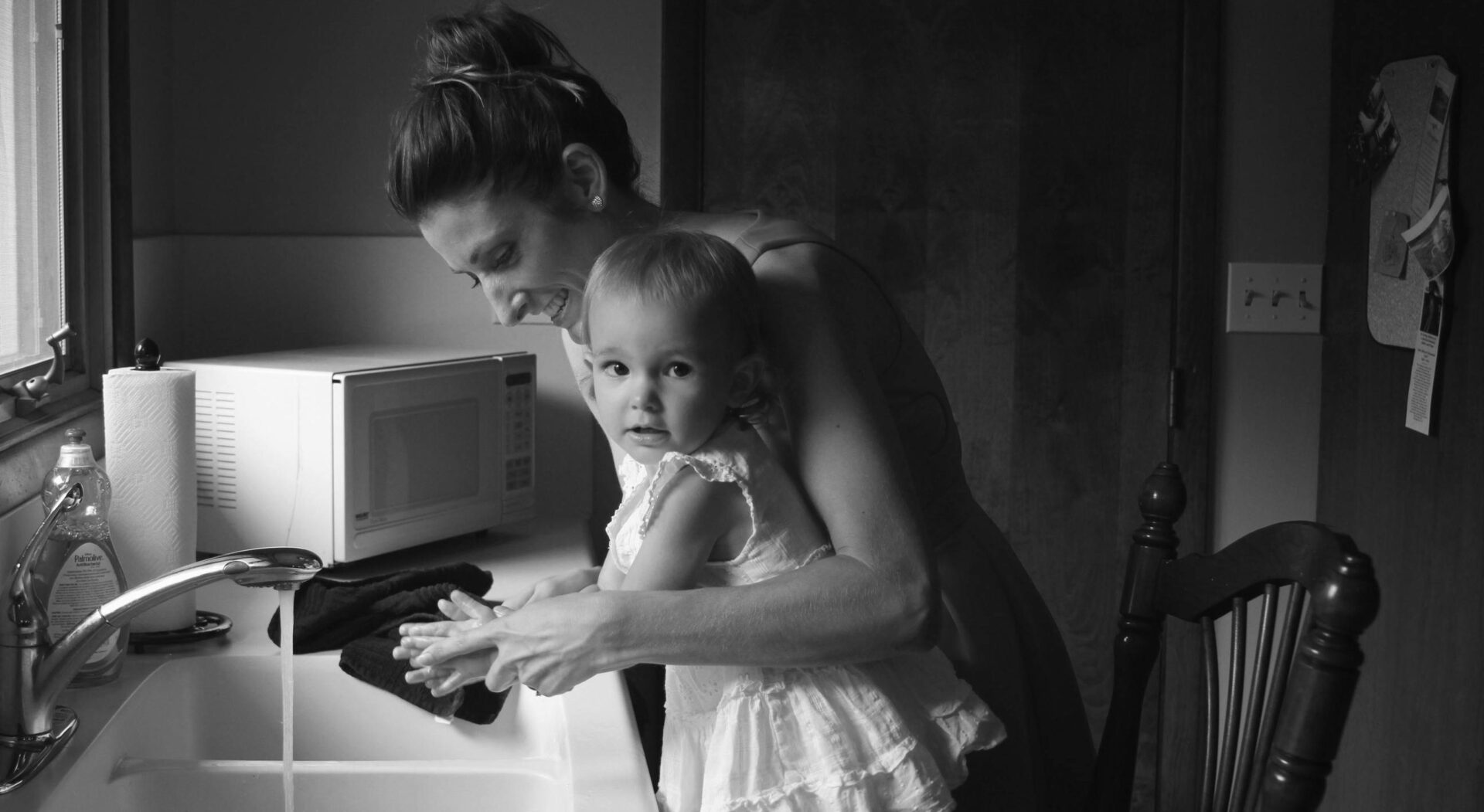Health
11 min Read
Turn these 6 nasty hygiene habits into good ones

February 28, 2020
Health
11 min Read

February 28, 2020

Anita Smith* has a couple ole’ pickers in the house. Her eldest son, now nine, picks his nose and eats it. Her seven-year-old son, Soren, is stealthier. No snacking, but definitely leaving a trail of, er, treasures on his bedroom wall. “I’ve explained why it’s a dirty habit, why it will literally make him sick but it doesn’t work,” says the Victoria, B.C. mom of three. “I’ve even told him that if he does pick his nose and there’s no tissue, to just wipe it on his socks because they get changed daily and washed often.”
Sigh…sound familiar? Indeed, teaching your newly independent early school ager proper hygiene habits is a bit challenging, yet critical from a health perspective. “There are several issues here and one is transmission of infectious diseases,” says Dr. Michelle Ponti, a pediatrician in London, Ont., and member of the Canadian Pediatric Society’s public education committee. “So the risk is to children themselves as well as a risk to those around them. And on top of that there’s the whole idea of what is socially acceptable behaviour.” But from nose picking to avoiding hand washing, these bad habits can require a lot of tedious teaching at home, school and daycare to successfully eradicate them. Check out our tips for tackling six of the dirtiest.
Germ patrol: Common flu and cold viruses linger inside noses and spread primarily via nasal-finger contact, but recent research has also found that more serious bacteria such as staph, can also be tucked away deep into noses.
Side effects: Colds, flu and even staphylococcus infections.
How do I fix it? Avoid shaming your child for doing this because that’s when the habit can turn secretive. “Sometimes children don’t even know they’re doing it. I often see children sitting with dripping noses and they aren’t even aware,” says Carolyn Taylor, a kindergarten teacher in Georgetown, Ont. Carolyn opts to redirect children, so she reminds them to take their fingers out, get a tissue and then wash their hands. Vigilance and consistency are key in squashing this habit so it helps to keep boxes of tissue stashed around the room at the children’s level so there’s no excuse not to use one, says Wendy Marshall, owner of Pumpkin Patch Daycare in Bolton, Ont., and president of the Association of Daycare Operators of Ontario. “Children learn that they have to wash their hands after they’ve done these things so they finally get to know that that’s something that requires a hand wash to stay healthy,” Wendy adds.
Germ patrol: Bacteria-laden plaque can build up on a child’s teeth if brushing and flossing are not done well.
Side effects: At its worst, plaque build-up can cause cavities and gingivitis.
How do I fix it? “Personal hygiene habits start with modelling by the parents,” says Penny Morka, a Winnipeg-based early years consultant. So getting a proper brushing might be as simple as doing it together in the bathroom. That way you can control how long the brushing will happen (dentists suggests teeth should be brushed for two minutes per session) or even make it fun once in awhile and let your child brush your teeth. Visual stimulation and positive reinforcement work well here, too. Create a chart where children get a check mark every time they brush and try to floss their teeth (let your child take a crack at it first and you follow by finishing the job) and offer rewards for regular intervals. Also, employ the many tools available on pharmacy shelves these days: light up or singing toothbrushes, colour-your-own toothbrushes and plastic-mounted flossers, which make it easier for kids to clean between their teeth.
Germ patrol: Anytime feces is left behind, it can contain viruses and bacteria including rotavirus, norovirus, salmonella and others.
Side effects: Touching feces exposes children to a host of illnesses ranging from flu and stomach flu to hand, foot and mouth disease.
How do I fix it? Are you finding, um, evidence of improper wiping after a bowel movement in your child’s underwear? It is amazing how some children like a squeaky clean bottom while others take a quick pass with toilet paper after the bathroom and aren’t bothered at all by what they’ve left behind. First, start with the basics: remind your child to wipe from front to back. Keep reminding them of this and also eyeball how much toilet paper they use. The over-sized wad they’re repeatedly rolling out may not be doing much.
“In general, we assist with this,” says Wendy. “Right from the early age, we give them the toilet paper and encourage them to do it themselves. And if there needs to be a little assistance, the teacher does help afterwards. We also encourage kids to take their time at this job because if they’re rushed, they don’t do it well.” If your child is struggling with wiping, think about stashing a package of flushable wet wipes on the back of the toilet to finish the job.
It’s important that as your child gets older to move them towards independence in this hygiene habit. “By always wiping your child’s bottom at home, you’re setting them up for failure at school,” says Carolyn. “So be your child’s coach. Coach and teach your child at every toilet visit, instead of quickly stepping in when it’s going wrong.”
Germ patrol: Once again, the concern is around cold and flu viruses primarily – sneezing or coughing out loud is the great escape for them. Other bacteria that can spread include pertussis and even some of the herpes family of viruses (though not the ones causing cold sores or genital infections).
Side effects: Colds, flu, staph infections, whooping cough, roseola and more.
How do I fix it? Have you been on the wrong end of a sneeze while helping your toddler pull on their boot? If your child is in daycare or preschool, they may have already learned the “sleeve sneeze” where you encourage your child to sneeze or cough into the crook of their elbow rather than their hands, because if they’re not washed afterwards, hands just continue to transmit germs. “Often schools will take pictures of kids doing the sleeve sneeze and that way it brings it down to their level and becomes a visual reminder that we put up in different places around the classroom,” says Penny. “You can even show a picture of someone not sneezing into his or her sleeve and posting it with an “x” over it like a nonsmoking sign. And then have a box of tissue right beside it so you’re offering them choices and reminding them at the same time.”
Germ patrol: Flu and cold viruses are the culprits here — but they’re not the only ones. Other viruses can include salmonella, campylobacter, MRSA and giardia.
Side effects: As Alberta Health notes, 80 percent of common infections are spread via our hands and this leaves children vulnerable to a host of illnesses ranging from the milder colds and fl u to the more serious giardia-induced diarrhea, salmonella, impetigo and more.
How do I fix it? Catch your child running out of the bathroom again with nary a drop of water touching their fingers? “We can’t stress good hand hygiene enough. It’s one of the easy ways to implement keeping ourselves risk-free or lowering our risk of disease transmission,” says Dr. Ponti. After all, a range of viruses can be carried via hands, ranging from the common cold virus to more serious ones. Food allergens can also be transferred from one person to another.
To start, make hand washing a routine: remind kids (and do it, too!) to wash their hands before eating, after using the bathroom and after coming in from outside. It’s best to allot some time for this critical hygiene habit so there’s no rushing, which is when some habits get skipped. “We try to use the easiest method of soap. Here at the daycare it’s attached to the wall and the paper towels are available right at the child’s level,” says Wendy. (At home, you could opt for an easy-pump soap instead of a bar which can take time to lather, and a low-level towel rack.) Also, remember that children are visual learners, so a step-by-step photo guide posted by the sinks can go a long way in reminding your child what’s expected of them in the bathroom. (Keep it simple: a picture of them turning on the tap, a picture of them lathering up, and so forth.)
And what about hand sanitizes? “Some parents send them along to school for security and to promote hand hygiene without having to supervise as much, but at that age, they’re going to need constant reminders to keep their hands clean,” says Dr. Ponti. So save the hand sanitizers for when you’re in a pinch and can’t get to soap and water. Also, it’s never too young to start with hand washing, or at least modelling it. Wendy says at Pumpkin Patch the children wash their hands even after a diaper is changed. “Some kids are touching themselves during diaper changing,” says Wendy. “And this way the kids are used to doing that before they ever use the toilet by themselves.”
Germ patrol: Skin picking can lead to open wounds, which open the door to a wide variety of viruses and bacteria such as staphylococcus aureus bacteria and impetigo.
Side effects: Open wounds leave kids vulnerable to a host of infections, depending on where they are and what they’re exposed to. At the least they could pick up warts, at worst, staph infections and more.
How do I fix it? “A lot of kids come to me because they’re ‘pickers,’ ” says Dr. Ponti. “So they habitually pick at their skin and lesions and occasionally it turns into nose picking as well.” To curb this habit, start by talking to your child about this behaviour, making sure to point out the consequences (it can lead to skin infections if wounds are created by picking). As parents, you can do a little prevention work. “Keep your child’s nails neatly trimmed, keep their skin and lips moist so that there’s not a little lesion or dry piece of skin that they’re constantly picking at,” she suggests. “For the nose, keep the air in your house well humidified, especially in the winter. And apply petroleum jelly inside and around the nose so there’s not the feeling that they have to
pick at something.”
If the habit is particularly bad, try keeping your child’s hands busy with a fidget toy so they have something to play with other than loose pieces of skin and nails.
Many of us grew up accustomed to eating food off the floor or drinking straight from the garden hose. We might wonder, are kids today too clean? Some studies show that more exposure to germs and dirt can lead to lower rates of allergies and asthma, as shown by a 2012 U.S. study of Amish children growing up on farms. For now though, a firm stance on the “too clean” issue is, well, soft. But we do know that research has generally eschewed the need for antibacterial soaps and gels; in fact, overusing these can lead to the build up of antibiotic resistant “super bugs”. Says Dr. Ponti, “I typically recommend gels if your hands don’t have any obvious dirt on them, but you want to clean them and can’t get to soap and water. But If you have actual dirt on your hands that you can see, you need to use soap and water.”
Originally published in ParentsCanada magazine, February/March 2016.